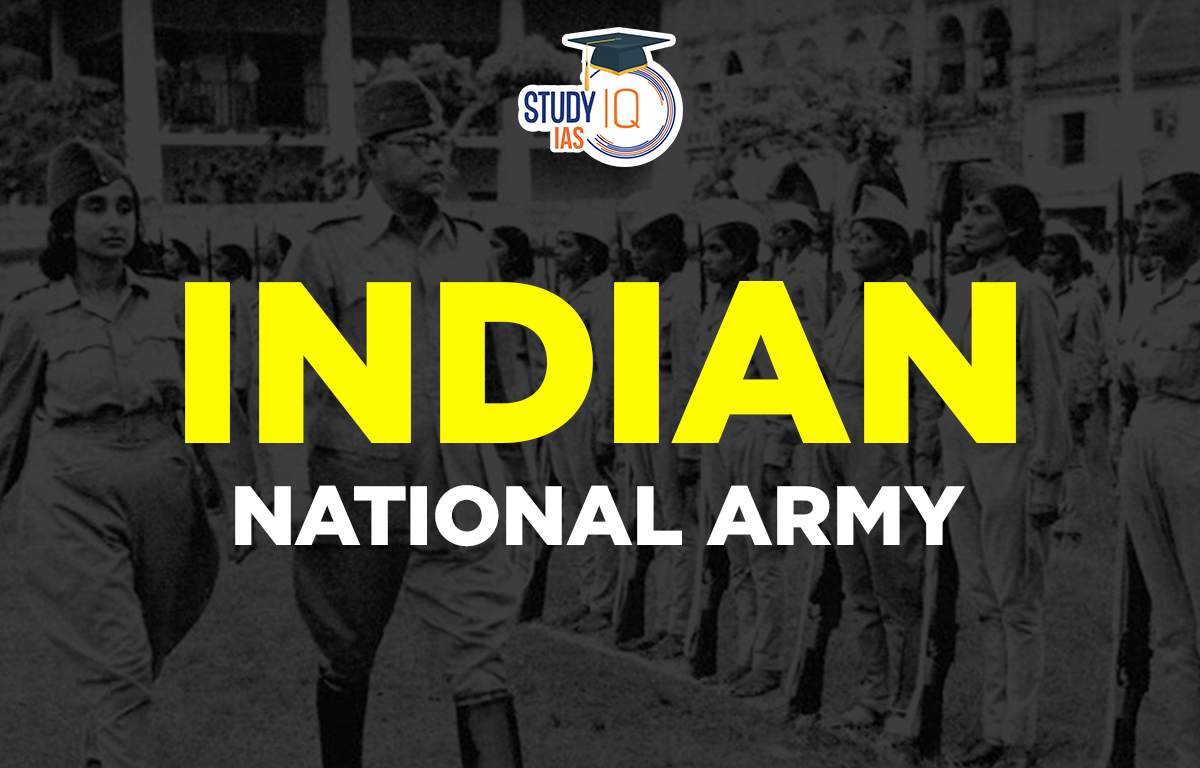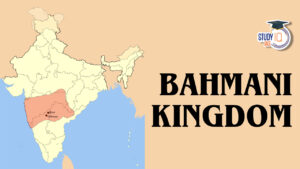Table of Contents
Indian National Army
The Indian National Army (INA), also known as Azad Hind Fauj, was a military force formed during World War II to secure India’s independence from British rule in 1942. The INA was closely associated with the charismatic nationalist leader Subhas Chandra Bose.
Japanese Army and the Indian Nationalists joined forces to create the Indian National Army. This force was established during World War II to aid India’s fight for independence from British rule. In 1942, Mohan Singh created this force out of the Indian POWs of the British Army who had been captured by Japan. The INA ultimately split up, but Netaji Subhas Chandra Bose helped the organization reform. The phases of the Indian National Army and Subhash Chandra Bose’s life will be covered in this article, which will be useful for UPSC exam preparation.
We’re now on WhatsApp. Click to Join
History of Indian National Army (INA)
Before the start of World War II, Japan and Southeast Asia hosted the majority of the displaced Indian Nationalists. At the beginning of World War II in Southeast Asia, 70,000 Indian soldiers were deployed along the shore of Malaya. Numerous Indian soldiers were captured prisoners of war after the Japanese army’s campaign along the coast of Malaya was successful. After Singapore fell, nearly 45,000 troops were captured on their own.
The first Indian National Army was created from these prisoners of war. Mohan Singh, a British-Indian Army officer captured during the Malayan Campaign, founded this force. There was an increase in volunteers who wished to join the INA as a result of the deplorable conditions in the PoW camps and the intense animosity towards the British army. Rash Behari Bose, an Indian Nationalist, was granted overall command of the army.
The Japanese Imperial Army, as well as those of Indian descent who lived in Southeast Asia, enthusiastically backed the INA. However, the INA was disbanded in 1942 as a result of disputes with the Japanese, particularly with Mohan Singh.
Indian National Army: First Phase
- The first phase of the Indian National Army (INA) refers to the initial period of its formation and activities during World War II.
- The INA, also known as Azad Hind Fauj, was created to achieve India’s independence from British rule. This phase is closely associated with the leadership of Netaji Subhas Chandra Bose, a prominent nationalist leader.
- In September 1942, during the early years of World War II, Bose formed the INA with the help of the Axis powers, primarily Imperial Japan.
- The INA’s first phase involved recruiting Indian prisoners of war, primarily from the British Indian Army, who were captured by the Japanese in Southeast Asia. Subhas Chandra Bose, who had earlier escaped house arrest in India, played a pivotal role in organizing and leading the INA.
- The INA’s first significant military engagement occurred in 1944 when it participated in the Burma Campaign against British and Allied forces alongside Japanese forces.
- The INA’s role in the conflict became a symbol of resistance against British colonial rule for many Indians.
Indian National Army: Second Phase
- The second phase of the Indian National Army (INA) is associated with its reorganization and renewed efforts during the later stages of World War II.
- This phase unfolded after the setbacks and changes that occurred following the INA’s initial engagements in the Burma Campaign.
- The INA’s second phase is marked by attempts to regroup, reorganize, and continue the struggle for India’s independence from British rule.
- Subhas Chandra Bose, the leader of the INA, sought to address the challenges faced during the first phase.
- In 1943, Bose formed the Provisional Government of Free India in Singapore, and he declared war against the British Empire. This move aimed to symbolize the INA’s commitment to the cause of Indian independence.
- The INA underwent a process of restructuring, with an emphasis on improving its military capabilities and addressing internal challenges. Efforts were made to enhance the INA’s collaboration with the Japanese forces, despite occasional differences in strategic goals.
- The most notable military campaign of the second phase was the INA’s participation in the Imphal-Kohima Campaign in 1944.
- The INA, alongside Japanese forces, engaged in fierce battles against British and Allied troops in Northeast India. However, the campaign did not achieve the desired success, and the INA faced a decisive defeat.
- The second phase of the INA concluded with the end of World War II in 1945. Japan’s surrender and the subsequent disintegration of the Axis powers had a profound impact on the fate of the INA. With the defeat of Japan, the INA faced a loss of support and resources.
- Despite the military setbacks, the Indian National Army and Subhas Chandra Bose’s efforts left a lasting impact on India’s struggle for independence.
- The INA’s role in challenging British rule and its association with the slogan “Dilli Chalo” (March to Delhi) became iconic symbols of the fight for freedom.
- The contributions of the INA and Bose to India’s independence movement are remembered as significant chapters in the nation’s history.
Indian National Army and Subhas Chandra Bose
The Japanese Army Command was furious at Mohan Singh’s deeds, but they nonetheless consented to the formation of a second Indian National Army. Subash Chandra Bose was proposed by Mohan Singh himself for the leadership post. His image as a devoted nationalist was known to the Imperial Japanese Army as well as the Indian diaspora in Southeast Asia. They were more receptive to the idea of Subash Chandra Bose commanding a nationalist army as a consequence.
Due to his activities in India, Subash Chandra Bose had to be detained by the British government; however, in 1941, he managed to flee and make it to Berlin. Although they were sympathetic to his cause, the German leadership was unable to help him raise an army to battle the Brits because of logistical problems. Subash Chandra Bose arrived in Singapore in July 1943 to assume command of the second Indian National Army, now known as the Azad Hind Fauj, at the invitation of the Japanese, who were prepared to support him.
Azad Hind Fauj took over by Subash Chandra Bose
- After Subash Chandra Bose took over the Azad Hind Fauj, there was a surge in volunteers seeking to join the INA. This interim administration, which declared war on both the United Kingdom and the United States, was recognised by the Axis countries. In addition to raising money for the INA, recruits were educated.
- Additionally, the Rani Jhansi Regiment, a female unit, was established. Army recruits were instructed to march from Rangoon (Burma), where the INA HQ had moved in January 1944, while spouting the battle cry “Chalo Delhi!”
Timeline of Indian National Army (INA)
- On November 6, 1943, the Japanese forces gave the INA control of the Andaman and Nicobar islands, which were renamed Shahid Dweep and Swaraj Dweep, respectively.
- On July 6, 1944, Subhas Bose hailed Mahatma Gandhi as “Father of the Nation” from Azad Hind Radio (the first person to address Gandhi as “Father of the Nation”). Gandhi’s approval was requested for “India’s final war of independence,” he said. The INA’s continued subordination to the Japanese Army was something Subash Chandra Bose accepted, but he saw it as a necessary step towards the ultimate objective of freeing India from the British Empire.
- The Japanese Army was allowed to bring one INA battalion, under the command of Shah Nawaz, to the Indo-Burma front and participate in the Imphal battle.
- The Indians were unjustly denied rations and weapons and made to perform menial tasks for Japanese troops, which disgusted and demoralised the INA units. Any dreams of the INA releasing the nation were dashed by Japan’s continued withdrawal after that.
- Up until mid-1945, the withdrawal continued. The Second World War ended with Japan’s capitulation on August 15, 1945, and the INA followed suit. Reports state that on August 18, 1945, Subhas Bose mysteriously perished in an aeroplane accident close to Taipei (Taiwan).
Indian National Army Operations
Bose believed that although the INA had to work as a subordinate under the Japanese Army, it was a necessary sacrifice for him to make to achieve his ultimate goal of releasing India from British control. In 1944, the INA took part in Operation U-Go, a Japanese offensive against British India. The INA, despite being successful in the early stages of the campaign, suffered a setback when they were compelled to retreat during the battles of Imphal and Kohima, in which the British decisively defeated the Japanese.
As a result, the INA lost a sizable number of troops and supplies throughout this retreat. The Japanese Army, which was already in decline, ordered many of the units to disband or merge. After Japan was vanquished in World War II, the British Army captured the majority of the Azad Hind Fauj. Bose escaped arrest and made his way to Dalian, which is close to the Soviet border, at the time of Japan’s capitulation in 1945. But soon after, it was claimed that he had perished in a plane crash close to Taiwan. The INA’s surviving members turned themselves into British Indian troops in Singapore following Bose’s passing.
Indian National Army UPSC
The Azad Hind Fauj’s primary objective from the start was Indian freedom, which the British attempted to hasten with the start of the Quit India Movement. It is safe to state that even in defeat, the Indian National Army prevailed over its colonial oppressors. We will always recall Subhash Chandra Bose for his bravery and selfless deeds. As part of the year-long celebrations and to honour Netaji Subhas Chandra Bose’s 125th birthday, the government recently decided to build a sizable statue of him at India Gate. His Jayanti is observed as “Parakram Diwas” on January 23.’
| Other Important Articles | |
| Kisan Sabha Movement | Eka Movement |
| Indian National Movement | Surat Split |
| Kakori Conspiracy | Vande Mataram Movement |
| Tebhaga Movement |
|


 Bahmani Kingdom (1347-1527 AD), History,...
Bahmani Kingdom (1347-1527 AD), History,...
 Indus River System, Tributaries, and Sin...
Indus River System, Tributaries, and Sin...
 Jallianwala Bagh Massacre, Date, History...
Jallianwala Bagh Massacre, Date, History...





















